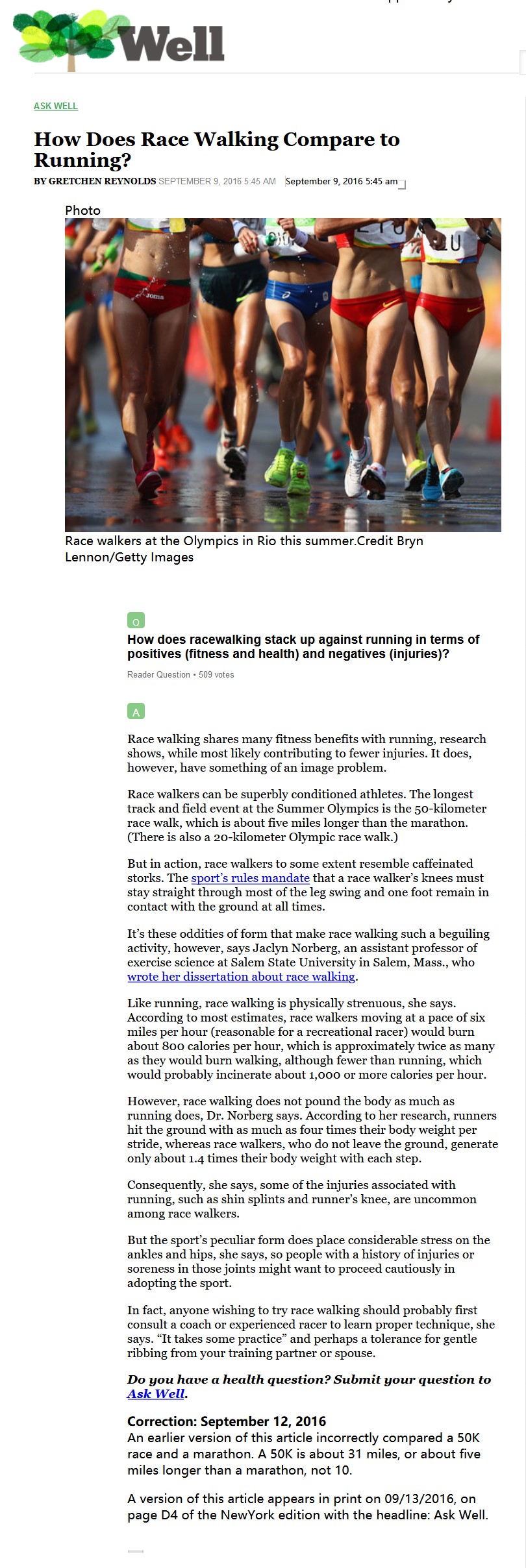6 2020年高考英语全国1卷阅读理解C原文出处
刚看到本站有一个关于expect doing sth的讨论(https://www.cpsenglish.com/question/47841),结果搞了半天,原来是个乌龙——命题人把原文的envision doing sth错改成了expect doing sth。这让我很好奇,我们是不是可以一起来挖一挖这些年来的高考阅读理解题的出处,看看高考英语阅读理解题到底来自什么样的材料,以及命题人是如何改编的。下面的是2020年高考英语全国1卷阅读理解,请大家找一下它的原文出处(指来自外刊的出处)是哪里?
2020年-高考英语-全国1卷-阅读理解B【寻求原文出处】
Race walking shares many fitness benefits with running, research shows, while most likely contributing to fewer injuries. It does, however, have its own problem.
Race walkers are conditioned athletes. The longest track and field event at the Summer Olympics is the 50-kilometer race walk, which is about five miles longer than the marathon. But the sport’s rules require that a race walker’s knees stay straight through most of the leg swing and one foot remain in contact (接触) with the ground at all times. It’s this strange form that makes race walking such an attractive activity, however, says Jaclyn Norberg, an assistant professor of exercise science at SalemStateUniversity in Salem, Mass.
Like running, race walking is physically demanding, she says. According to most calculations, race walkers moving at a pace of six miles per hour would burn about 800 calories (卡路里) per hour, which is approximately twice as many as they would burn walking, although fewer than running, which would probably burn about 1,000 or more calories per hour.
However, race walking does not pound the body as much as running does, Dr. Norberg says. According to her research, runners hit the ground with as much as four times their body weight per step, while race walkers, who do not leave the ground, create only about 1. 4 times their body weight with each step.
As a result, she says, some of the injuries associated with running, such as runner’s knee, are uncommon among race walkers. But the sport’s strange form does place considerable stress on the ankles and hips, so people with a history of such injuries might want to be cautious in adopting the sport. In fact, anyone wishing to try race walking should probably first consult a coach or experienced racer to learn proper technique, she says. It takes some practice.
最佳答案 2021-01-26 13:01
【以下是该高考真题原题材料出处网址】
https://well.blogs.nytimes.com/2016/09/09/how-does-race-walking-compare-to-running/
【以下是该高考真题原题材料出处文档】
How Does Race Walking Compare to Running?
By Gretchen Reynolds | September 9, 2016 5:45 am | September 9, 2016 5:45 am
Race walkers at the Olympics in Rio this summer. Credit Bryn Lennon/Getty Images
Q
How does racewalking stack up against running in terms of positives (fitness and health) and negatives (injuries)?
Reader Question • 509 votes
A
Race walking shares many fitness benefits with running, research shows, while most likely contributing to fewer injuries. It does, however, have something of an image problem.
Race walkers can be superbly conditioned athletes. The longest track and field event at the Summer Olympics is the 50-kilometer race walk, which is about five miles longer than the marathon. (There is also a 20-kilometer Olympic race walk.)
But in action, race walkers to some extent resemble caffeinated storks. The sport’s rules mandate that a race walker’s knees must stay straight through most of the leg swing and one foot remain in contact with the ground at all times.
It’s these oddities of form that make race walking such a beguiling activity, however, says Jaclyn Norberg, an assistant professor of exercise science at Salem State University in Salem, Mass., who wrote her dissertation about race walking.
Like running, race walking is physically strenuous, she says. According to most estimates, race walkers moving at a pace of six miles per hour (reasonable for a recreational racer) would burn about 800 calories per hour, which is approximately twice as many as they would burn walking, although fewer than running, which would probably incinerate about 1,000 or more calories per hour.
However, race walking does not pound the body as much as running does, Dr. Norberg says. According to her research, runners hit the ground with as much as four times their body weight per stride, whereas race walkers, who do not leave the ground, generate only about 1.4 times their body weight with each step.
Consequently, she says, some of the injuries associated with running, such as shin splints and runner’s knee, are uncommon among race walkers.
But the sport’s peculiar form does place considerable stress on the ankles and hips, she says, so people with a history of injuries or soreness in those joints might want to proceed cautiously in adopting the sport.
In fact, anyone wishing to try race walking should probably first consult a coach or experienced racer to learn proper technique, she says. “It takes some practice” and perhaps a tolerance for gentle ribbing from your training partner or spouse.
Do you have a health question? Submit your question to Ask Well.
A version of this article appears in print on 09/13/2016, on page D4 of the NewYork edition with the headline: Ask Well.
Correction: September 12, 2016
An earlier version of this article incorrectly compared a 50K race and a marathon. A 50K is about 31 miles, or about five miles longer than a marathon, not 10.
【以下是该高考真题原题材料出处截图】

- 3 关注
- 2 收藏,13424 浏览
- 丁群丽 提出于 2021-01-23 23:49
相似问题
- 2020年高考英语全国1卷语法填空材料出处 1 回答
- 2020年高考英语全国1卷完形填空材料出处 1 回答
- 2020年高考英语全国1卷阅读理解A材料出处 1 回答
- 2020年高考英语全国1卷阅读七选五原文出处 3 回答
- 2020年高考英语全国1卷阅读理解D原文出处 1 回答
-
 《高考英语备考1号·速效编》
《高考英语备考1号·速效编》
-
 《高考英语备考1号·写作编》
《高考英语备考1号·写作编》
-
 《高中英语晨读晚记》
《高中英语晨读晚记》
-
 《高中英语错题笔记》
《高中英语错题笔记》
-
 《零起点考大学英语》
《零起点考大学英语》
-
